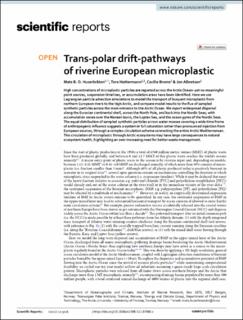| dc.contributor.author | Huserbråten, Mats Brockstedt Olsen | |
| dc.contributor.author | Hattermann, Tore | |
| dc.contributor.author | Broms, Cecilie | |
| dc.contributor.author | Albretsen, Jon | |
| dc.date.accessioned | 2022-06-21T07:52:46Z | |
| dc.date.available | 2022-06-21T07:52:46Z | |
| dc.date.created | 2022-04-13T13:56:19Z | |
| dc.date.issued | 2022 | |
| dc.identifier.citation | Scientific Reports. 2022, 12 . | |
| dc.identifier.issn | 2045-2322 | |
| dc.identifier.uri | https://hdl.handle.net/11250/2999732 | |
| dc.description.abstract | High concentrations of microplastic particles are reported across the Arctic Ocean–yet no meaningful point sources, suspension timelines, or accumulation areas have been identified. Here we use Lagrangian particle advection simulations to model the transport of buoyant microplastic from northern European rivers to the high Arctic, and compare model results to the flux of sampled synthetic particles across the main entrance to the Arctic Ocean. We report widespread dispersal along the Eurasian continental shelf, across the North Pole, and back into the Nordic Seas; with accumulation zones over the Nansen basin, the Laptev Sea, and the ocean gyres of the Nordic Seas. The equal distribution of sampled synthetic particles across water masses covering a wide time frame of anthropogenic influence suggests a system in full saturation rather than pronounced injection from European sources, through a complex circulation scheme connecting the entire Arctic Mediterranean. This circulation of microplastic through Arctic ecosystems may have large consequences to natural ecosystem health, highlighting an ever-increasing need for better waste management. | |
| dc.language.iso | eng | |
| dc.subject | Økosystem | |
| dc.subject | Ecosystem | |
| dc.subject | Havmodeller | |
| dc.subject | Ocean modelling | |
| dc.subject | Mikroplast | |
| dc.subject | Microplastic | |
| dc.subject | Forurensing | |
| dc.subject | Pollution | |
| dc.subject | Arktis | |
| dc.subject | Arctic | |
| dc.title | Trans-polar drift-pathways of riverine European microplastic | |
| dc.title.alternative | Trans-polar drift-pathways of riverine European microplastic | |
| dc.type | Peer reviewed | |
| dc.type | Journal article | |
| dc.description.version | publishedVersion | |
| dc.source.pagenumber | 10 | |
| dc.source.volume | 12 | |
| dc.source.journal | Scientific Reports | |
| dc.identifier.doi | 10.1038/s41598-022-07080-z | |
| dc.identifier.cristin | 2017196 | |
| dc.relation.project | Norges forskningsråd: 280727 | |
| cristin.ispublished | true | |
| cristin.fulltext | original | |
| cristin.qualitycode | 1 | |
